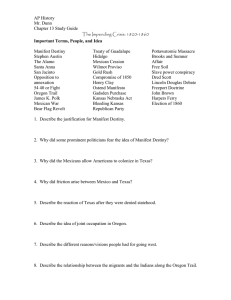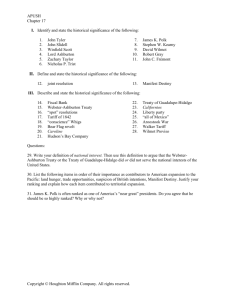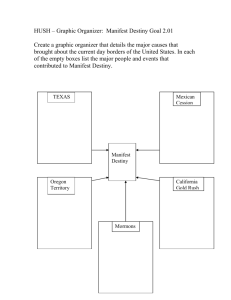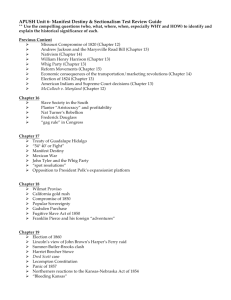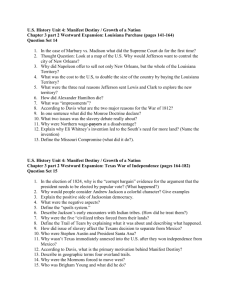APAH Reading Guide Name: Chapter 13 Directions – After reading
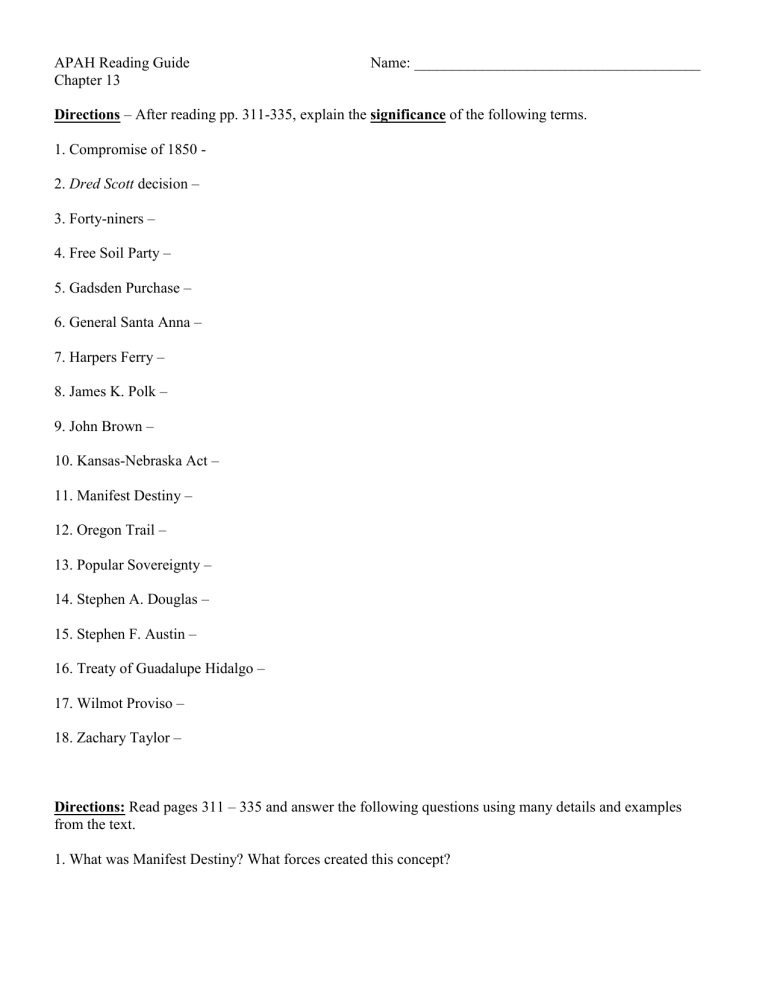
APAH Reading Guide
Chapter 13
Name: ______________________________________
Directions – After reading pp. 311-335, explain the significance of the following terms.
1. Compromise of 1850 -
2. Dred Scott decision –
3. Forty-niners –
4. Free Soil Party –
5. Gadsden Purchase –
6. General Santa Anna –
7. Harpers Ferry –
8. James K. Polk –
9. John Brown –
10. Kansas-Nebraska Act –
11. Manifest Destiny –
12. Oregon Trail –
13. Popular Sovereignty –
14. Stephen A. Douglas –
15. Stephen F. Austin –
16. Treaty of Guadalupe Hidalgo –
17. Wilmot Proviso –
18. Zachary Taylor –
Directions: Read pages 311 – 335 and answer the following questions using many details and examples from the text.
1. What was Manifest Destiny? What forces created this concept?
2. How did Manifest Destiny reflect American nationalism?
3. What was the "empire of liberty"? What doubts were raised as to its desirability?
4. How did Texas become available for annexation? What prevented its immediate annexation?
5. What was the history of American interest in Oregon?
6. What were the characteristics of western immigrants? What problems did they face? How were these overcome?
7. What were the goals of President Polk? How did he resolve the Oregon question?
8. Why did Polk earn the enmity of northerners and westerners alike?
9. What tensions emerged in the Southwest that threatened to lead the United States into a war with Mexico?
10. How did American interest in California develop?
11. On what grounds did Polk ask Congress to declare war on Mexico?
12. On what grounds was Polk's call for war criticized?
13. What was the Wilmot Proviso? What brought about its introduction, and what arguments were advanced in its favor?
14. What were the South's arguments against the Wilmot Proviso? On what points did they differ from the arguments of the North?
15. How did the gold rush change the cultural composition of California?
16. What problems faced President Zachary Taylor when he took office?
17. What was the Compromise of 1850? How was it passed?
18. Who were the "younger" politicians who emerged after 1850? How did they differ from the leaders they replaced?
19. How did the political parties and sections of the nation react to the Compromise of 1850?
20. How did the issue of a transcontinental railroad help to reopen the sectional controversy? Explain.
21. How did the North react to the Kansas-Nebraska Act? The South? What effect did it have on the Whigs?
The Democrats?
21. Who were the Republicans? What caused their formation? Which groups composed this party, and what was the party's platform
22. What problems were faced in the attempt to organize a legitimate government in Kansas? Why did these problems arise? How was it that Kansas became a battleground for the sectional controversy?
23. Explain the maneuvering by pro-slavery and antislavery forces to gain control of the Kansas government.
What did both sides come to believe that Kansas symbolized for the nation?
24. What types of society did northerners wish to create? How did "free soil" and "free labor" fit into their plans? Why did they feel that the South was holding them back?
25. How did the "free soil" ideology manifest itself in the Republican Party? What diverse views did it unite?
26. What were the elements of the South's pro-slavery response? Who were its major spokespersons?
27. What effect did the depression of 1857 have on political divisions in America? How did it increase the tension between the North and the South?
28. What were the origins of the Dred Scott case? What issues were involved, and what decision did the
Court hand down? How did the reaction to this case add to sectional tensions?
29. Why did the Lincoln-Douglas debates take place, and why did they draw so much attention? How did
Lincoln and Douglas differ on their solution to the question of slavery in the territories?
30. What were the goals of John Brown's raid, and why did it have such an impact on the South?
31. What caused the split between northern and southern Democrats in 1860, and what was the result of this division?
32. What was the Republican platform in 1860? To what specific political groups were the Republicans trying to appeal, and how did this platform propose to appeal to them?
33. Why was compromise ineffective from 1820-1860?
34. Explain how President Polk personifies Manifest Destiny.
35. Historical Causation : Explain how the following events helped create further division between the
North and the South.
Kansas-Nebraska Act –
Dred Scott Decision –
John Brown’s Raid at Harpers Ferry –
Election 1860 –
A
B
C
D
E
F
G
H
I
36. Periodization : Explain why historians see the creation of the Republican Party in the 1850s as the start of the 3 rd political party system. Did the new Republican Party really signal such a decisive break with past politics?
37. Synthesis : Determine the validity of the following statement and justify your answer. “While most
Americans believed Manifest Destiny was a positive and progressive movement, it should be more factually described as aggressive imperialism that was pursued at the expense of many other people.”
38. Historical Causation, Periodization, Comparison, Contextualization : The map on page 7 shows the expansion of the United States from 1820-1850. For each letter representing territorial acquisition, identify the name of the territory, the president (s) who acquired the land, the method it was acquired, and how it changed the United States.
Name of Territory President (s) Method of Acquisition How it changed the US
J Spanish Florida James Madison
Annexed from Spain
1810-1812
Pleased War Hawks, Satisfied citizens concerned about
Indian raids on the border.
G
G
F
A
H
D
B
I
C
J
E
